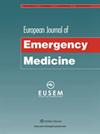Videodistraction to reduce agitation in elderly patients in the emergency department: an open label parallel group randomized controlled trial.
IF 3.1
4区 医学
Q1 EMERGENCY MEDICINE
引用次数: 0
Abstract
BACKGROUND AND IMPORTANCE Agitation of elderly patients in the emergency department (ED) often complicates workup and therapy. OBJECTIVE In this study, we investigated if agitation in the ED can be reduced by showing calming video sequences in elderly agitated patients. DESIGNS Prospective randomized intervention study. SETTINGS AND PARTICIPANTS ED patients aged ≥65 years were screened for the risk of agitation/delirium using the 4-A's test (4-AT) test. In case of ≥4 4-AT points, patients were scored using the Richmond Agitation-Sedation Scale (RASS) and the Nursing Delirium Screening Scale (Nu-DESC). They were included in the study if RASS was ≥+2 and Nu-DESC ≥ 4 after informed consent of the legal representative. Patients were then randomized to the intervention or control group. A total of n = 57 patients were included in the study. INTERVENTION Patients in the intervention group were exposed to projections of calming video sequences for 60 min. Patients in the control group received standard care. OUTCOME MEASURES AND ANALYSIS Changes in RASS and Nu-DESC were assessed 30 and 60 min after the intervention was started. MAIN RESULTS A total of 57 patients were included in the study, with 30 patients in the intervention group and 27 patients in the control group. Before the intervention, the median (interquartile range) RASS scores were comparable between the intervention group [3 (2-3)] and the control group [3 (2-3)]. After 30 min of exposure to calming video sequences, patients in the intervention group showed significantly lower RASS and Nu-DESC scores compared to the control group [RASS: 1 (0-1) vs. 2 (1.5-3), P < 0.001; Nu-DESC: 3 (2-4) vs. 5 (4-6), P < 0.001]. This difference persisted at 60 min [RASS: 0 (0-1) vs. 2 (1-2.5), P < 0.001; Nu-DESC: 2 (2-3) vs. 5 (4-6), P < 0.001]. Additionally, fewer patients in the intervention group required additional sedating or antipsychotic medication (1/30) compared to the control group (9/27), with this difference being statistically significant (P = 0.004). CONCLUSION In this randomized controlled trial, the use of calming video sequences in elderly patients with agitation in the ED resulted in significant reductions in agitation and the need for additional sedative or antipsychotic medication.通过视频牵引减少急诊科老年患者的躁动:一项开放标签平行分组随机对照试验。
背景和重要性急诊科(ED)中老年患者的躁动通常会使诊疗工作复杂化。目的在这项研究中,我们探讨了是否可以通过播放视频片段来缓解急诊科中老年躁动患者的躁动。如果 4-AT 分数≥4 分,则使用里士满躁动不安量表(RASS)和护理谵妄筛查量表(Nu-DESC)对患者进行评分。经法定代理人知情同意后,RASS≥+2且Nu-DESC≥4的患者被纳入研究。然后,患者被随机分配到干预组或对照组。共有 n = 57 名患者参与了这项研究。干预干预组患者将接受 60 分钟的平静视频投影。结果测量和分析在干预开始 30 分钟和 60 分钟后评估 RASS 和 Nu-DESC 的变化。主要结果共有 57 名患者参与研究,其中干预组 30 人,对照组 27 人。干预前,干预组[3 (2-3)]和对照组[3 (2-3)]的 RASS 评分中位数(四分位数间距)相当。在观看 30 分钟的镇静视频后,干预组患者的 RASS 和 Nu-DESC 分数明显低于对照组[RASS:1 (0-1) vs. 2 (1.5-3),P < 0.001;Nu-DESC:3 (2-4) vs. 5 (1.5-3),P < 0.001]:3 (2-4) vs. 5 (4-6),P < 0.001]。这种差异在 60 分钟后仍然存在[RASS:0 (0-1) vs. 2 (1-2.5),P < 0.001;Nu-DESC:2 (2-3) vs. 5 (4-6),P < 0.001]:2 (2-3) vs. 5 (4-6),P < 0.001]。此外,与对照组(9/27)相比,干预组中需要额外服用镇静剂或抗精神病药物的患者更少(1/30),这一差异具有统计学意义(P = 0.004)。
本文章由计算机程序翻译,如有差异,请以英文原文为准。
求助全文
约1分钟内获得全文
求助全文
来源期刊
CiteScore
3.60
自引率
27.30%
发文量
180
审稿时长
6-12 weeks
期刊介绍:
The European Journal of Emergency Medicine is the official journal of the European Society for Emergency Medicine. It is devoted to serving the European emergency medicine community and to promoting European standards of training, diagnosis and care in this rapidly growing field.
Published bimonthly, the Journal offers original papers on all aspects of acute injury and sudden illness, including: emergency medicine, anaesthesiology, cardiology, disaster medicine, intensive care, internal medicine, orthopaedics, paediatrics, toxicology and trauma care. It addresses issues on the organization of emergency services in hospitals and in the community and examines postgraduate training from European and global perspectives. The Journal also publishes papers focusing on the different models of emergency healthcare delivery in Europe and beyond. With a multidisciplinary approach, the European Journal of Emergency Medicine publishes scientific research, topical reviews, news of meetings and events of interest to the emergency medicine community.
Submitted articles undergo a preliminary review by the editor. Some articles may be returned to authors without further consideration. Those being considered for publication will undergo further assessment and peer-review by the editors and those invited to do so from a reviewer pool.

 求助内容:
求助内容: 应助结果提醒方式:
应助结果提醒方式:


